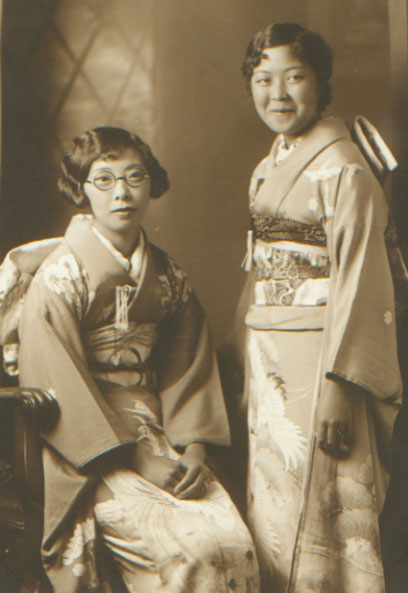Exhibit: Santa Barbara Asian American & Pacific Islander Heritage, 1870s-1970s
Kinzo Fukushima (1869-1945) and Fuji (Tanaka) Fukushima (1873-1939)
Creating a Family Legacy in Santa Barbara Japantown
By Melinda Yamane Crawford

Kinzo and Fuji Fukushima (on left)
Early History
Kinzo Fukushima was born on December 29, 1869, in Kumamoto-ken, Japan. He arrived in the United States in 1903. Together, he and his wife, Fuji (Tanaka) Fukushima, raised their family which included sons Masashi and Hiroshi and daughters Mikae, Shizu and Shigeko. Both in terms of their family and businesses built, they left behind a rich Japanese family history and legacy in Santa Barbara, California.
Kinzo is said to have been raised as a gentleman and appeared to have had some family wealth. By 1910, he owned a Japanese boarding house and employment agency located at 125 E. Canon Perdido St., a grocery store at 111. E. Canon Perdido St., and the family home at 129 1/2 Canon Perdido St. – all of which were then part of the vibrant Santa Barbara Japantown in the historic Santa Barbara Presidio neighborhood.
While Kinzo was listed as the owner of these businesses and their home residence, it was his wife, Fuji, who had the necessary business skills as she was the one to manage their family businesses. In addition, she was known to be a tofu-maker and had renown as a local midwife, having earned her California midwife credentials on April 24, 1918. Fuji would often travel to Japan, and it was during one such trip in 1939 that she passed away.
Detention
On Friday, March 6, 1942, the Santa Ynez Valley News had reported that Kinzo Fukushima of Summerland had been arrested on Monday, March 2, 1942 and was being held in the county jail. At the time of his arrest, he was in possession of a camera and two flashlights in his home.

Kinzo and Fuji Fukushima Family
His grandson, Dave Nishihara, recently shared the following account of what had actually occurred:
My father [Hideo George Nishihara] and mother [Shigeko Elizabeth (Fukushima) Nishihara] rented out the family compound on Canon Perdido St. and rented land on Ortega Hill to grow tomatoes, and they started a packing house in Summerland. Grandpa was arrested as the family was living in a house with a privy, and he used the flashlight to go to the bathroom. The light was seen, and it was suspected he was trying to signal to vessels out at sea.
Following his arrest, Kinzo was sent to Tule Lake Relocation Center in Modoc County, CA, just 35 miles southeast of Klamath Falls and about 10 miles from the town of Tulelake. It was here at Tule Lake that Kinzo was incarcerated for the duration of the war and died on August 20, 1945. Altogether, there were at least 331 people who died while incarcerated at Tule Lake. However, the cemetery inside the camp’s perimeter, where the deceased who were not cremated were buried, no longer exists. Similar to but also tragically different from the stories of the Japantown and Chinatown that once existed in Santa Barbara, the Japanese cemetery was bulldozed over some years ago by local homesteaders.

Shizu and Shigeko Fukushima
Other Family Stories and Notable Careers
Shizu (Fukushima) Honda (1906-1941) and Grandson Shigeru Irwin Honda (1927-2001)
Shigeko Elizabeth (Fukushima) Nishihara (1914-1999) and George Hideo Nishihara (1909-1998)
Shigeko Fukushima, the third and youngest daughter of Kinzo and Fuji, was born and raised in Santa Barbara. She married George Hideo Nishihara, who trained in Japan as a shoji screen maker and began his cabinet-making business in Santa Barbara. Together, they raised their five children – four were born in Santa Barbara, and one (Takeo) was born and died at the Gila Rivers Relocation Camp following the family’s arrival and incarceration on August 21, 1942.
The Nishihara Siblings
Hideko Elizabeth (Nishihara) Malis (1935-present) was the long-time business owner of Coast Blueprint Company. Like Hideko, Victoria “Vicki” Anne (Nishihara) Woolford (1951-present) currently lives in Santa Barbara; however, she also lived previously in Hawaii for some 40 years. Their younger brother, David “Dave” Hideo Nishihara (1948-present), recently retired as an Oakland Police Sergeant. Two other siblings, Takeo Nishihara (1943-1943) and Yoshiko Joan Nishihara (1939-2003) are remembered and honored along with their parents and grandparents.

George Hideo Nishihara
Acknowledgements
Warm thanks to Dave Nishihara for sharing his family history, stories and photographs, to Davy Forrester who captured his family history in a well-produced video for his 8th grade family history project, and also to Hideko Malis, Vicki Woolford and Bonnie Forrester for their support and contributions.
References
“Canon Perdido Street: A Family History,” by Davy Forrester, Mark Day School, 8th Grade Family History Project, June 2022. Courtesy of Dave Nishihara and Bonnie Forrester. https://vimeopro.com/
“David-and-Goliath Battle Over Tule Lake”, by Barbara Takei, Rafu Shimpo, January 28, 2023. Accessed at: https://rafu.com/2023/01/
“Fujie Fukushima”. California, U.S.,O Occupational Licenses, Registers, and Directories, 1876-1969.
“Hideo George Nishihara”. U.S., Final Accountability Rosters of Evacuees at Relocations Camps, 1942-1946. Accessed on Ancestry.com.
“Japanese Lover Wins Lady Love”. The Los Angeles Times, May 13, 1925, pg. 26. Newspapers.com, accessed on Ancestry.com.
“Kinzo Fukushima”. California, U.S., Death Index, 1940-1997. Accessed on Ancestry.com.
“Kinzo Fukushima”. Santa Barbara, California, U.S., City Directory, 1910. Accessed on Ancestry.com.
“Kinzo Fukushima”. Santa Barbara Ward 5, Santa Barbara, California, U.S., !910 Federal Census. Accessed on Ancestry.com.
“Kinzo Fukushima”. U.S., Final Accountability Rosters of Evacuees at Relocation Camps, 1942-1946. Accessed on Ancestry.com.
“Kinzo Fukushima’s Arrest”. Santa Ynez Valley News, March 6, 1942, pg. 1. Newspapers.com, accessed on Ancestry com.
